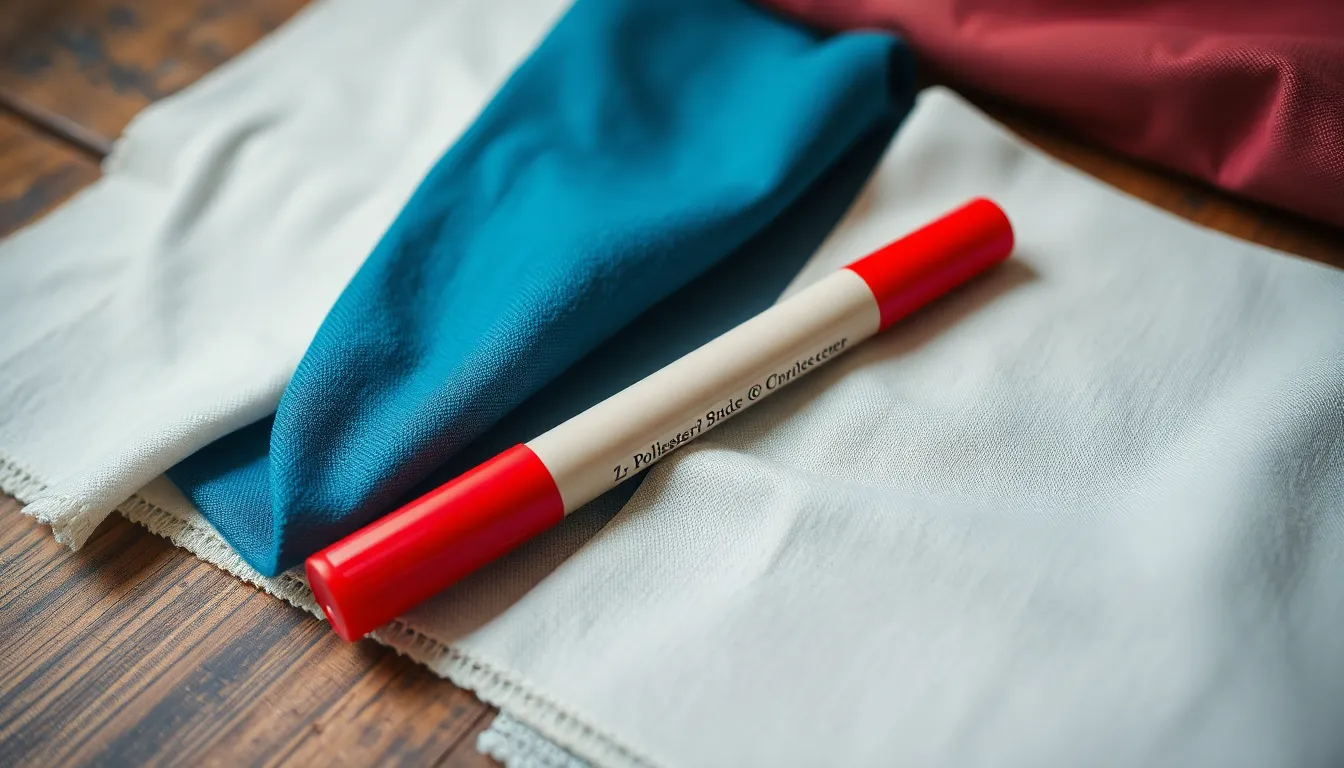Picture this: you’re at a meeting, jotting down brilliant ideas with an Expo marker, when suddenly, the unthinkable happens. A rogue swipe leaves a colorful streak across your favorite shirt. Panic sets in. Will that vibrant ink be the end of your wardrobe staple? Fear not! The world of stains is more forgiving than it seems.
Table of Contents
ToggleUnderstanding Expo Markers
Expo markers are popular dry-erase markers used in various settings, from classrooms to offices. These markers contain ink that can create vivid, easy-to-remove markings on whiteboards.
Composition of Expo Markers
Expo markers consist mainly of dye, alcohol, and a resin. Dyes provide color, while alcohol helps the ink dry quickly. Resins aid in adherence and play a crucial role in the removal process from surfaces. The combination of these components makes Expo markers effective for writing yet potentially problematic when they come into contact with fabric.
How Expo Markers Stain Clothes
When the ink from an Expo marker contacts clothing, the stains can cause concern. Fabric fibers absorb the dye, leading to visible marks that can be challenging to eliminate. Stains often worsen if left untreated, as the alcohol evaporates and sets the dye into the fabric. Immediate action helps improve the chances of successful removal and reduces the risk of permanent damage.
Factors Affecting Stain Removal

Several factors influence the success of removing an Expo marker stain. Understanding these variables can significantly improve the chances of restoring garments to their original condition.
Fabric Type
Fabric type plays a crucial role in stain removal. Natural fibers like cotton and linen absorb ink more readily than synthetic fibers such as polyester or nylon. Synthetic materials often resist staining due to their tighter weave. Each fabric type reacts differently to cleaning methods. For instance, cotton may withstand harsher treatments to lift stains, while delicate fabrics like silk require gentler approaches. Testing cleaning solutions on an inconspicuous area helps determine fabric tolerance before treating the stain.
Time of Stain
Time of stain presents another vital aspect of removal. The sooner action occurs after staining, the higher the chances of success. Fresh stains are often easier to treat compared to older ones, as the ink has not fully set into the fibers. Immediate blotting with a clean cloth can prevent the ink from spreading and becoming entrenched. Waiting hours or longer may allow the dye to bond more with the fabric, making it significantly harder to eliminate. Quick response times are essential for maximizing stain removal efficacy.
Methods to Remove Expo Marker Stains
Removing Expo marker stains is manageable with the right techniques. Effective methods range from home remedies to commercial stain removers.
Home Remedies
Utilizing common household items can help eliminate Expo marker stains. Rubbing alcohol acts as a solvent, effectively breaking down the ink. Use a clean cloth to blot the stained area, avoiding scrub motions that may spread the stain. Baking soda can also provide relief; create a paste with water, apply it to the mark, and let it sit for 10 to 15 minutes before rinsing. Another effective option involves using vinegar. Mix equal parts vinegar and water, apply it to the stain, and dab with a cloth. Testing any remedy on an inconspicuous area is crucial to prevent fabric damage.
Commercial Stain Removers
Commercial stain removers specifically designed for ink can offer a powerful solution. Look for products labeled as ink stain removers, ensuring they are safe for the fabric type. Apply the remover directly to the stain following package instructions. Many of these products require a short waiting period for optimal results. Washing the clothing afterward can further help in removing residual stains and chemicals. Consider stain removers containing enzymes or alcohol as they often yield more effective results against stubborn ink marks. Always read the label to confirm compatibility with your fabric.
Effectiveness of Cleaning Methods
Stain removal effectiveness varies depending on the method chosen. Each approach can yield different results based on the fabric type, the age of the stain, and the cleaning agents used.
Comparative Results
Home remedies like rubbing alcohol, vinegar, and baking soda often provide promising results on cotton and linen. In contrast, synthetic fabrics like polyester generally resist staining but may require specialized treatments for ink removal. Commercial stain removers designed specifically for ink stains show high effectiveness, especially those containing enzymes or alcohol. Testing each method on inconspicuous areas helps gauge potential fabric reactions. Many users report that immediate stain treatment leads to better outcomes compared to delayed actions.
Tips for Success
Act quickly after an Expo marker stain appears to enhance removal chances. Blotting the stain gently with a clean cloth minimizes ink spread and absorption. Always use cold water, as hot water may set the ink. Apply cleaning solutions sparingly to prevent fabric damage. Following instructions on commercial products ensures proper usage and optimal results. Reassessing the effectiveness of the chosen method can guide adjustments for stubborn stains. Employing these techniques increases the likelihood of restoring clothing to its original condition.
Dealing with Expo marker stains doesn’t have to be a daunting task. With the right approach and prompt action, it’s possible to restore clothing to its original condition. Understanding the fabric type and the age of the stain is crucial for selecting the most effective cleaning method. Whether opting for home remedies or commercial stain removers, following the appropriate steps can significantly enhance the chances of successful removal. By acting quickly and using the right techniques, anyone can tackle these pesky stains and keep their favorite clothes looking fresh and clean.






